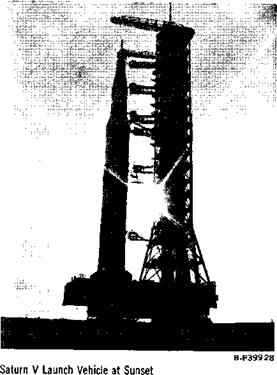EARLIER SATURNS
Saturn I
Studies which led to the Saturn family of rockets were started by the Wernher von Braun organization in April of 1957. The aim of the program was to create a 1.5 million-pound-thrust booster by clustering previously developed and tested engines.
On Aug. 15, 1958, the Advanced Research Projects Agency I ARP A) formally initiated what was to become the Saturn project. The agency, a separately organized research and development arm of the Department of Defense, authorized the Army Ballistic Missile Agency to conduct a research and development program at Redstone Arsenal for a 1.5
Test Vehicle… The first assembled Apollo Saturn V vehicle
approaches the launch pad at Kennedy Space Center. It was used to verify launch facilities, train launch crews, and develop test and checkout procedures at KSC. It was roiled out on
May 25, 1966.
million-pound-thrust vehicle booster. A number of available rocket engines were to be clustered and tested by a full-scale static firing by the end of 1959.
The program objectives were expanded by ARPA in October of 1958 to include a multi-stage carrier vehicle capable of performing advanced space missions. Concurrent with the development of a multistage vehicle, static test facilities at Redstone Arsenal and launch complex facilities at Cape Canaveral—now Cape Kennedy—were being constructed.
The proposed large vehicle project was officially renamed Saturn on Feb. 3, 1959, by ARPA memorandum. The space agency assumed technical direction of the Saturn project in Sate 1959. The project was transferred officially on Mar. 16. I960, and the Army development group at Huntsville was transferred to NASA and became the nucleus of the new Marshall Space Flight Center. The first staticfiring of a Saturn I booster was conducted April 29, 1960.
![]()
|
SATURN V NEWS REFERENCE
The NASA Saturn Vehicle Evaluation Committee (Silverstein Committee) on Dec. 15, 1959, recommended a long-range development program for a Saturn vehicle with upper stage engines burning liquid hydrogen and liquid oxygen. The initial vehicle, identified as Saturn C-l and now as Saturn I, was to be a stepping stone to a larger vehicle. A building-block concept was proposed that would yield a variety of Saturn configurations, each using previously proven developments as far as possible.
Early in I960 the Satum program was given the highest national priority, and a 10-vehicle research and development program was approved.
The two-stage Saturn I vehicle with the Apollo spacecraft was about 188 feet tall and weighed some
1,125,0 pounds at liftoff.
While plans for the lunar mission were progressing, the Saturn I project made history. On Oct. 27, 1961, the first Saturn I booster was flight tested successfully from Cape Kennedy. The first flight booster with dummy upper stages was called SA-1. This vehicle was followed by successful flights of SA-2 on April 25, 1962, SA-3 on Nov. 16, 1962, and SA-4 on Mar. 28, 1963.
The SA-5 vehicle, combining the first stage (S-l) with the second stage (S-IV), was successfully launched on Jan. 29, 1964, with both stages functioning
|
1-4 |
perfectly to place a 37,700-pound payload into earth orbit. SA-6, launched on May 28, 1964, and SA-7, launched on Sept. 18,1964, each placed “unmanned” boilerplate configurations of Apollo spacecraft into earth orbit.
SA-9, launched on Feb. 19, 1965, was the first Saturn I vehicle to launch a Pegasus meteoroid technology satellite into earth orbit.
The SA-8 and SA-10 Satum I vehicles were successfully launched on May 25, 1965, and July 30, 1965, respectively, also placing a Pegasus satellite into earth orbit to complete the test and launch program with an unprecedented 100 per cent record of success.











